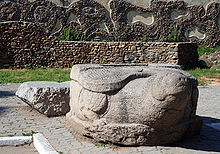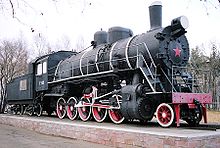- Ussuriysk
-
Ussuriysk (English)
Уссурийск (Russian)- City[citation needed] - Coordinates: 43°48′N 131°57′E / 43.8°N 131.95°ECoordinates: 43°48′N 131°57′E / 43.8°N 131.95°E Coat of arms Administrative status Country Russia Federal subject Primorsky Krai Municipal status Urban okrug Ussuriysky Urban Okrug[citation needed] Mayor[citation needed] Sergey Ruditsa[citation needed] Statistics Area 173 km2 (67 sq mi)[citation needed] Population (2010 Census,
preliminary)158,000 inhabitants[1] - Rank in 2010 111th Population (2002 Census) 157,759 inhabitants[2] - Rank in 2002 109th Density 913 /km2 (2,360 /sq mi)[3] Time zone VLAST (UTC+11:00)[4] Founded 1866[citation needed] Postal code(s) 692500–692527[citation needed] Dialing code(s) +7 4234[citation needed] Official website Ussuriysk (Russian: Уссури́йск) is a city in Primorsky Krai, Russia, situated in the fertile valley of the Razdolnaya River, 98 kilometers (61 mi) north of Vladivostok. The city is about 60 kilometers (37 mi) from both the Chinese border and the Pacific Ocean.
Contents
History
Medieval history
From the middle of the ninth century, the territory of what now is Ussuriysk was located in the kingdom of Balhae. Prior to that, the area was settled by Yulou Mohe tribes.
Modern era
In 1866, the settlement of Nikolskoye (Никольское) was founded on the area of today's Ussuriysk, named after Saint Nicholas. Due to its advantageous geographic location at the crossing of the transportation lines of South Primorye, the village experienced rapid growth during the 1870s, turning into a trade center. The role of the village increased after the railroad connecting Khabarovsk and Vladivostok (now part of the Trans-Siberian Railway) was built, and in 1898 it was given town status and renamed Nikolsk-Ussuriysky (Никольск-Уссурийский).
By the beginning of the 20th century the town's population totaled 15,000 people, and the annual turnover of its trade enterprises was equal to three million rubles. After the Russo-Japanese War of 1904-1905, Nikolsk-Ussuriysky became one of the most important commercial and economic centers of the Russian Far East. In 1913 the city ranked fourth after Vladivostok, Blagoveshchensk, and Khabarovsk in terms of population. Enterprises were established processing agricultural products such as mills, dairies, soap-boiling plants and tanneries, as well as macaroni and sausage factories and breweries. Brick factories, quarries and saw-mills also appeared in the city.
The central part of the city began to be built up with two- and three-story masonry buildings. In 1914, there were fourteen educational institutions, a theater, a circus, and three movie-theaters in Nikolsk-Ussuriysky.
After the October Revolution of 1917, Ussuriysk's economy experienced rapid growth. The city specialized in processing agricultural products. The town's named changed again to Voroshilov in 1935 after Kliment Voroshilov. With Nikita Khrushchev's ascent to power after Stalin's death the city's name was changed to Ussuriysk after the nearby Ussuri River in 1957.
Until the 1980s, the city ranked second in the krai in population, having only recently yielded to Nakhodka. Ussuriysk is still second only to Vladivostok as a theatrical and higher-educational center (it is home to the Pedagogical and Agricultural Institutes, and the Higher Military School).
Business and industry
The city's industry is represented by 28 enterprises, including 12 of the food industry, 2 of light industry, 6 of metal industry, and 4 of construction industry. Ussuriysk has always specialized in the production of consumer goods. That is why at present it is in a more favorable situation as compared with other large cities of Primorye where enterprises of war industry prevailed. The largest enterprises of light industry are Primorsky Sakhar (which provides the Russian Far East with sugar, producing 160,000 tonnes per year), Dalsoya (which produces vegetable oil, margarine, and soap), Ussuriysky Balsam (24 kinds of liqueur and vodka products, and balsams made of a blend of dozens of herbs). Five articles of Ussuriysky Balsam were given diplomas of the first and the second degrees at all-Russian competition of alcohol products.
One more economic feature of Ussuriysk is its wholesale trade. There are approximately 30 specialized and multipurpose trade bases many of which had developed contacts with foreign partners before the external economic policy was liberalized in Russia.
Among the city's other enterprises that are worth mentioning are the Grado firm which annually produces up to 600,000 pairs of footwear, and the Locomotive Repairing Plant. The annual industrial output of Ussuriysk equals 8% of Krai's production. Besides, the city is the crossing point of all major highways and railroads of Primorye.
Animal husbandry is well-developed in Ussuriysky District.[clarification needed] Soybeans, buckwheat, wheat, barley, potatoes, and vegetables are grown here.[citation needed] Manufacture of furs is also developed in this District. Oktyabrsky JSC supplies mink fur-skins to the Russian market and abroad.
The joint Ussuriysky Administration has worked out a program of social and economic development in the city and the District. This presupposes an active exploration of the deposits of mineral sources found in the territory of the city and the district, namely, hard and brown coal, tuff, and clay. Foreign investors are welcome in the mining of these sedimentary rocks.
Theaters
The Ussuriysk Drama Theater of the Far East Military District is located at #31 Sovyetskaya St. The theater was founded in 1937 and is one of the two theaters of the Russian Army (the other is the Central Theater of the Russian Army in Moscow). The theater maintains the military–patriotic tendency and realistic style.
The Ussuriysk Drama Theater is located at #33 Volodarskogo St. It was opened in 1937. The theater is of classical tendencies. Plays are staged both for adults and children. The hall can accommodate 428 people.
Geography
The downtown including Lenina, Chicherina, Krasnoznamyonnaya, and Ageyeva Streets is of historic value. The city's oldest hotel (#28 Lenina St.) was constructed in 1880. #53 Lenina St. which houses the city's oldest movie-theater Grand-Illyuzion was built in 1908.
On the central square there is a monument to the Red Guards and partisans, who died in the battles at Ussuriysk in June 1918. A monument to Lenin is on the Railway Station Square.
Steam locomotive YeL 629 is set on plinth as a memorial to 3 Bolshevik revolutionaries (Lazo, Lutsky and Sibirtsev) who were roasted alive by White Guards in its firebox in 1920.
The Intercession Church at #80A Chicherina St. was built in 1914. It is Primorsky Krai's only religious building which has been kept without any reconstruction since 1917 and used for its original purpose.
Ussuriysk is very green because of many trees (such as poplars, elms, and jasmine, have been transplanted here from the taiga) and ranked third after Arsenyev and Vladivostok.
International relations
Twin towns/sister cities
Ussuriysk is twinned with:
See also
- Ussuriysk Astrophysical Observatory
External links
References
- ^ Федеральная служба государственной статистики (Federal State Statistics Service) (2011). "Предварительные итоги Всероссийской переписи населения 2010 года (Preliminary results of the 2010 All-Russian Population Census)" (in Russian). Всероссийская перепись населения 2010 года (All-Russia Population Census of 2010). Federal State Statistics Service. http://www.perepis-2010.ru/results_of_the_census/results-inform.php. Retrieved 2011-04-25.
- ^ Федеральная служба государственной статистики (Federal State Statistics Service) (2004-05-21). "Численность населения России, субъектов Российской Федерации в составе федеральных округов, районов, городских поселений, сельских населённых пунктов – районных центров и сельских населённых пунктов с населением 3 тысячи и более человек (Population of Russia, its federal districts, federal subjects, districts, urban localities, rural localities—administrative centers, and rural localities with population of over 3,000)" (in Russian). Всероссийская перепись населения 2002 года (All-Russia Population Census of 2002). Federal State Statistics Service. http://www.perepis2002.ru/ct/doc/1_TOM_01_04.xls. Retrieved 2010-03-23.
- ^ The value of density was calculated automatically by dividing the 2010 Census population by the area specified in the infobox. Please note that this value may not be accurate as the area specified in the infobox does not necessarily correspond to the area of the entity proper or is reported for the same year as the population.
- ^ Правительство Российской Федерации. Постановление №725 от 31 августа 2011 г. «О составе территорий, образующих каждую часовую зону, и порядке исчисления времени в часовых зонах, а также о признании утратившими силу отдельных Постановлений Правительства Российской Федерации». Вступил в силу по истечении 7 дней после дня официального опубликования. Опубликован: "Российская Газета", №197, 6 сентября 2011 г. (Government of the Russian Federation. Resolution #725 of August 31, 2011 On the Composition of the Territories Included into Each Time Zone and on the Procedures of Timekeeping in the Time Zones, as Well as on Abrogation of Several Resolutions of the Government of the Russian Federation. Effective as of after 7 days following the day of the official publication).
Administrative divisions of Primorsky Krai Administrative center: Vladivostok Cities and towns Arsenyev · Artyom · Bolshoy Kamen · Dalnegorsk · Dalnerechensk · Fokino · Lesozavodsk · Nakhodka · Partizansk · Spassk-Dalny · Ussuriysk
Urban-type settlements Dunay · Gornorechensky · Gorny · Gornye Klyuchi · Kavalerovo · Khasan · Khrustalny · Kirovsky · Kraskino · Lipovtsy · Luchegorsk · Novoshakhtinsky · Olga · Plastun · Pogranichny · Posyet · Preobrazheniye · Primorsky · Putyatin · Rudny · Shkotovo · Sibirtsevo · Slavyanka · Smolyaninovo · Svetlaya · Terney · Vostok · Vysokogorsk · Yaroslavsky · ZarubinoDistricts Anuchinsky · Chernigovsky · Chuguyevsky · Dalnerechensky · Kavalerovsky · Khankaysky · Khasansky · Khorolsky · Kirovsky · Krasnoarmeysky · Lazovsky · Mikhaylovsky · Nadezhdinsky · Oktyabrsky · Olginsky · Partizansky · Pogranichny · Pozharsky · Shkotovsky · Spassky · Terneysky · YakovlevskyRussian Far East Topics Federal subjects Largest cities Vladivostok · Khabarovsk · Komsomolsk-on-Amur · Blagoveshchensk · Yakutsk · Petropavlovsk-Kamchatsky · Yuzhno-Sakhalinsk · Nakhodka · Ussuriysk · Magadan · BirobidzhanCategories:- Cities and towns in Primorsky Krai
- Populated places established in 1866
Wikimedia Foundation. 2010.





